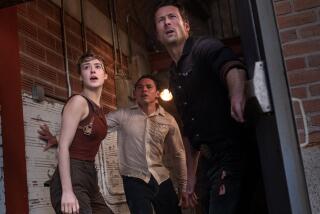Small Texas town’s first picture show won’t be its last dose of Hollywood, thanks to resident author.
- Share via
ARCHER CITY, Tex. — There is something vaguely familiar about this wide-swept Texas town. It jars a traveler’s memory, whispering softly, “You have been here before.” Yet the traveler knows he hasn’t, and his mind’s eye reaches back, as though examining an old black-and-white photograph for clues.
The traffic light hanging over Main and Center streets blinks a constant red, cutting through afternoon dust-haze as thick as talcum powder. A Greyhound bus stops, then rumbles south toward Abilene.
The town is still again, seemingly forsaken like the gutted stone building that stands abandoned across from the courthouse.
“What was that building, the one that’s fallen down over there?” the traveler asks, pointing.
“Why, way back, that was the Royal Theater,” says one of the Walsh brothers on “knowledge corner”--the gas station by the traffic light where Archer City’s old-timers gather each morning to pass the day.
The Royal Theater? Of course. The traveler has been here before. So have millions of other Americans, who 20 years ago knew Archer City as Anarene in the film adaptation of Larry McMurtry’s novel “The Last Picture Show.” This is where Sonny Crawford (Timothy Bottoms) lost his innocence to the middle-aged wife of the high school coach and Duane Jackson (Jeff Bridges) lusted for sexy Jacy Farrow (Cybill Shepherd).
Town Outraged
Directed by Peter Bogdanovich, the black-and-white movie became a cult classic of growing up in the ‘50s and of the stultifying drabness of small-town Texas life. Its filming here was the biggest thing that had happened to Archer City since Jesse and Frank James used to hide out at the nearby home of their friend Allen Parmer.
The town headed off en masse to Wichita Falls, 25 miles north, for the opening. Its collective response of outrage was loud enough to muffle the prairie winds.
The Baptist preacher said the movie was sinful and urged his followers not to read the book or see the movie (although it was not certain he had done either). Some locals accused McMurtry, who was graduated from Archer City High School in 1954, of being a Benedict Arnold, and reporters from around the country traipsed into town to see if Archer City truly was the end of the earth as Hollywood had portrayed it.
McMurtry, in a letter to the editor of the local weekly paper, offered to debate his critics in a public forum at the American Legion hall. None accepted.
“Frankly, it was the Baptists that made all the noise,” said lifelong resident Jane Ceay. “I think it was mostly jealousy. Instead of being proud of Larry, they were resentful of his success. That’s how small towns are.”
Hometown Pride
But while the Baptist minister has long since left Archer City, McMurtry has come home, and Archer City has embraced its only literary son. It honored him with a dinner at the Country Club after his novel “Lonesome Dove” won the Pulitzer Prize, and Carolyn Parish, the bartender at American Post No. 198--the only place that serves alcohol in town--says proudly: “Around here, he’s not Mr. McMurtry. He’s Larry to us.”
McMurtry does much of his writing on an old manual typewriter at the family ranch house in the east end of the county, and he recently purchased the Taylor mansion on the Archer City golf course as a guest home for friends and wandering writers. He also helped his sister, Sue Deen, set up the only bookstore between Abilene and Wichita Falls, which they named the Blue Pig in honor of the animal mentioned in the first sentence of “Lonesome Dove.” Deen has trouble stocking enough signed copies of McMurtry’s books.
Tough Times
Still, even McMurtry would have to admit that Archer City is not a handsome place. Once a cattle town, it became increasingly dependent on oil during the energy boom, then fell on tough times, along with the rest of Texas, when oil prices dropped.
So today the town’s most famous monument--the Royal Theater that was a focus of “The Last Picture Show”--stands as a skeleton of three walls, and no one can figure out whether it’s worth the expense to rebuild it. The theater had closed well before the filming of the movie and it was brought back to life only by Hollywood wizardry.
To make Archer City look as forlorn as possible, designers also put false, weather-beaten fronts on the shops next door and blew leaves and sagebrush through “knowledge corner” with giant fans. The pool parlor that actor Ben Johnson ran in the movie (it was actually a place to play dominoes) was razed a few years ago.
Preparing for Sequel
Once financing is arranged, Bogdanovich and many of the original actors in “The Last Picture Show” are scheduled to return to Archer City to film McMurtry’s 25-years-later sequel, “Texasville.” Local residents are already inquiring where they can sign up for parts as extras and inquiring what time the American Legion will hold the lunch buffets for the crew.
“The bad taste that the movie left for some folks, that’s gone now,” said the high school principal, Nat Lunn. “They’re looking forward to being filmed again. Especially with money being short in town, they’re ready for another dose of Hollywood.”
More to Read
Only good movies
Get the Indie Focus newsletter, Mark Olsen's weekly guide to the world of cinema.
You may occasionally receive promotional content from the Los Angeles Times.










